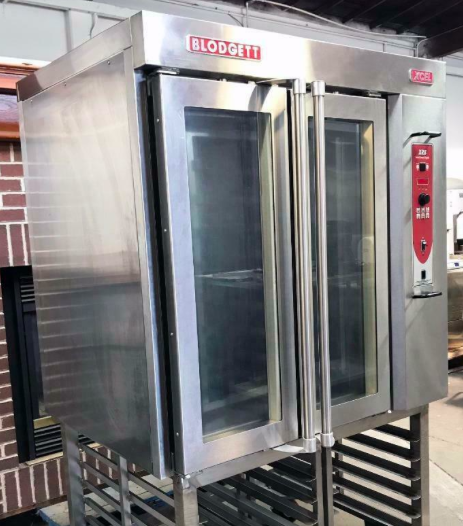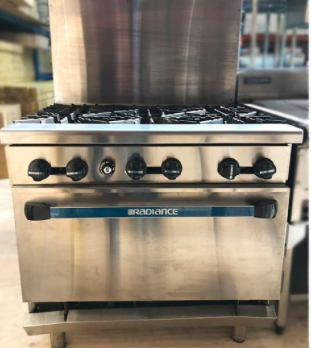It’s a fact: You can spend almost any amount of money you can imagine on outfitting your commercial kitchen with the latest state-of-the-art cooking and kitchen equipment you need to produce top-notch food for your hungry customers, while keeping your staff happy, safe, and working at their most efficient.
Browse our full inventory of used cooking and kitchen equipment below. Each listing contains photos, detailed descriptions and condition of the unit. Click here to browse our full inventory of used restaurant equipment priced at a massive discount.
[display_listings l_type=”90″]
Introduction

For many small business owners, whether it’s a small, mom-and-pop restaurant, a full-blown Michelin-starred restaurant with 100 seats, or even a small village store, cafe, or diner, the purchase of cooking and kitchen equipment will be one of the single largest parts of the overall operating budget.
Whether you’re outfitting a brand new restaurant kitchen from the ground up, or simply looking to replace a broken-down piece of equipment that’s been with you through years of service, shopping for used cooking and kitchen equipment can be a great way to save money and keep your budget on track.
Is Buying Used Cooking and Kitchen Equipment a Wise Choice?

The decision to buy used cooking and kitchen equipment instead of new is a bit of a personal choice. Let’s look at a few of the pros and cons:
Pro: Commercial grade cooking and kitchen equipment is built to last. Because of the rigors of always-on cooking in a hectic professional restaurant environment, most commercial cooking and kitchen equipment is built to last. Typically, you can expect commercial-grade ranges, griddles, ovens, refrigerators, and even sinks and dishwash machines to be built with more durable materials, heavy gauge steels, more welded joints, and higher BTU outputs than their residential or consumer-grade counterparts. Because much of this equipment is so well-built, these pieces can outlast many of the small businesses in which they are installed. Which brings us to our next point…
Pro: Used cooking and kitchen equipment is easy to find and plentiful. Let’s face it: Many (or even most!) food businesses simply don’t make it. Often, a wild-eyed restauranteur with a big dream and an even bigger amount of money to burn will go on a kitchen cooking equipment shopping spree, decking out his or her kitchen in tens (or even hundreds) of thousands of dollars in new equipment, only to find their restaurant closing a few years (or a few months!) later. Suddenly, all of this semi-new equipment is sitting in storage, or needs to be liquefied to pay the bills, and that’s where a savvy shopper can step in and find some amazing deals on used equipment.
Con: Purchasing used equipment means you may face the repairman sooner. No matter how well it has been cared for, used cooking and kitchen equipment is still just that: Used. This means that sooner or later, something is going to fail, and necessitate a visit from the commercial appliance repairman. Most used equipment is no longer covered by a warranty, which means that as the new owner, you will probably be forced to eat the full cost of repairs. Of course, being careful about your purchase and doing your due diligence before plunking down your cold, hard cash can alleviate this risk somewhat, but no matter what, you’re going to need repairs sooner than on a brand-spanking-new piece of equipment.
Con: Used equipment may not be as pretty. Stay with us for a minute. Who cares what the equipment looks like, as long as it gets hot (or cold!) quickly, and does the job it’s supposed to do? In many kitchen environments, this may hold true. But with the continuing trend of “open kitchens” playing a big part of any restaurant space, you may want to think twice before you install a secondhand floor fryer with a decade’s worth of grease caked to the side, or a beverage cooler previously owned by someone with an enormous collection of Pantera stickers. Like it or not, customers gazing into an open kitchen want to see brand new, sparkling clean pieces of equipment, and buying used may make that more difficult.
Pro: You can probably haggle on the price of used cooking and kitchen equipment. Unlike shopping for new equipment, where the prices tend to be pretty fixed unless you are purchasing a ton of pieces at the same time, there’s always room to haggle a bit on the price of used items, whether you’re buying from an individual, or a showroom that specializes in used commercial kitchen equipment. Like buying a new car, the value of a new major item like a range or refrigerator drops dramatically the moment it leaves the showroom floor, which means there are great deals to be had on used pieces of equipment.
General Guidelines for Buying Used Cooking and Kitchen Equipment

While the “rules” for shopping for used cooking and kitchen equipment vary somewhat, depending on the type of piece you’re interested in buying, there are a few tried-and-true guidelines for making a smart, financially responsible purchase. Among these:
When in doubt, opt for name-brand manufacturers. The general logic here is this: If the piece of equipment you are considering was considered “top of the line” when it was new, it’s probably going to hold up better in the long run. This is particularly true for large appliances, such as refrigerators, ranges, ovens, or prep units. Avoid no-name or off-brand manufacturers, who often use cheaper materials, poorer insulation, and who may even factor in repair costs into their business models.
Gas appliances tend to outlast their electric counterparts. If your location allows for either gas or electric appliances, gas is probably the wiser investment, when purchasing used. Propane and natural gas powered appliances tend to be a little simpler than electric, and simpler mechanics mean that there are fewer points of potential failure (and costly repairs).
Older, basic models may outlive and outperform newer technologies. Some of the best pizzerias in the world are built around gigantic, single-deck pizza ovens that are almost a century old, and still performing as well as they did when they were brand new.
Why? Because they’re dead simple. A million pounds of cast iron, some fire, and a simple ignition system are all that’s required by some of these older appliances, which ensures they have the potential to keep running for generations. While bells and whistles like touchscreen displays, electronic readouts, and computer-controlled temperature regulation may be convenient (and fun!) to use, remember that every single one of these “features” has the risk of breaking down and crippling the entire unit at any point. In general, we recommend searching for used cooking and kitchen equipment that’s as light on “extra” features as possible.

Don’t be distracted by the cosmetic condition of the equipment. If the used 6-burner range you’re considering has what seems like an entire stock pot of pea soup filling every crack and crevice, or the inside of the oven you’re looking at has never been cleaned in its life, don’t let that be the focus of your evaluation.
Sure, we’d all love to buy a used piece of equipment that’s sparkling clean, and ready to plunk into our kitchen just in time for a surprise visit from the health inspector. But the fact is, most commercial used cooking and kitchen equipment gets used pretty hard, and cleaning and maintenance schedules may not have been followed to the letter.
Remember that commercial cleaners and solvents are magical things; we’ve seen pieces of equipment that looked destined for the scrap heap brought back to near-showroom condition with just a few hours of elbow grease. Of course, if the piece of equipment you’re considering is particularly funky, consider using that as a negotiating point to land a lower price.
